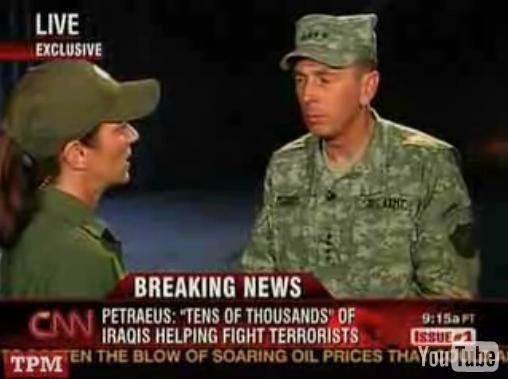
One of the things that's badly hamstrung the effort to bring a sense of clarity to the Iraq War is that five years in, too many media professionals still seems either unaware of basic facts in the Iraq theater or willfully ignorant of same. Subsequently, a metric ton of essential truth is waylaid by either a lack of curiosity or the effective manipulations of war-supporting surrogates. There are broad ramifications - such as the gentle treatment of GOP nominee John McCain, who gets credited with recognizing the "mistakes" Bush made after we went to war without ever having to account for the fact that the war was a mistake in the first place - but, as always, the real devil lies in the details.
This was never more apparent than in CNN's Kyra Phillips and her interview with General David Petraeus on the occasion of the war's fifth anniversary. Despite possessing the outward appearance of journalistic rigor, the interview only reinforced, with very little pushback, some central errors pertaining to the Iraq miasma. As Talking Points Memo noted last week, one head-thumping moment came when Phillips blithely made the same erroneous contention that John McCain made all last week - that Iran was funneling resources and material support to al-Qaeda. As David Kurtz put it, "Maybe John McCain gets his foreign policy briefings from CNN, or maybe it's vice versa."
On that matter, Petraeus offered a quiet correction that Phillips never acknowledged. But the bigger example of flim-flam might have been Petraeus' contention on who was responsible for the recent uptick in violence:
PETRAEUS: Well, interestingly, the week through last Friday actually saw a reduction in the overall level of attacks throughout Iraq. But clearly there have been also in recent weeks some of these headline-grabbing attacks, sensational attacks, if you will, in the tragic one in particular is the suicide vest attack in Karbala. Again, al Qaeda is intent on reigniting sectarian violence. They have tried to do this all along. We're not sure exactly why.
That General Petraeus, sage military expert, can get away with saying that he's "not sure exactly why" al Qaeda does the things it does is pretty extraordinary. But maybe the reason he's loathe to ascribe them motives is because he'd rather not explain how we've come to be pinned down by this shadowy organization known as "al Qaeda in Iraq" or AQI. If he were to spend too much time providing an explanation, Kyra Phillips might be forced to conclude that AQI is little more than a strenuously over-hyped boogeyman.
This is not to say that there aren't reporters on the ground who understand that AQI is little more than a Rotary Club version of the notorious terror organization. CNN's been uniquely blessed by the talents of Michael Ware, who offered his assessment on the July 17, 2007 broadcast of Anderson Cooper 360, concluding that "al Qaeda would be lucky to make up three percent of the insurgency," and that White House efforts to portray them as anything other than a minor player in Iraq's violence amounted to a willful deception: "They are trying to play the American public."
Ware has not been alone in subjecting the matter to scrutiny. Brian Williams called Petraeus out on conflating AQI with the terrorists who attacked the Pentagon and the World Trade Center. This alone, is a critical point of distinction: those magic words - "al Qaeda" - are one of the few ways the Bush administration gets to connect the Iraq distraction with the perpetrators of 9/11, all without ever having to account for the nagging fact that al Qaeda didn't have an Iraq-based presence until the invasion created a window of opportunity for one. It came buried in the piece, but the adminstration's contentions with regard to AQI also got some pushback from the New York Times' Jim Ruttenberg and Mark Mazzetti last July - countering the "surge of facts" that the White House was pimping at the time.
Actual intelligence estimates tend to downplay the threat that AQI supposedly poses - at best, AQI gets credit for being up to fifteen percent of the total insurgency, and just as often, they are relegated to being between 2-5%. In fact, the triumph of AQI has got less to do with their achievements in the field of terrorism, and more to do with the ironclad tautology that the administration has erected to pin the tail of our misfortune on a convenient, scary sounding donkey, something a June 8 AP article, titled "In motley array of Iraqi foes, why does U.S. spotlight al-Qaida?", makes rivetingly clear:
Since Iraqis rose up against the U.S. occupation in 2003, the insurgency has spawned a long roster of militant groups -- the 1920 Revolution Brigades, Islamic Army in Iraq, Ansar al-Sunnah, Mujahedeen Army, the Mahdi Army, among others -- drawing on loyalists of the ousted, Sunni-dominated Baathist regime, other nationalists, Islamists, tribal groups and militant Shiites.
Some 30 groups now claim responsibility for attacks against U.S. and government targets, said Ben Venzke, head of the Virginia-based IntelCenter, which tracks such statements for the U.S. government.
Despite this proliferation of enemies, the U.S. command's news releases on American operations focus overwhelmingly on al-Qaida.
During the first half of May, those releases mentioned al-Qaida 51 times, against just five mentions of other groups. When other groups tangle with U.S. forces, they're often described as "al-Qaida-linked," mainly those in the Islamic State of Iraq, an alliance that is dominated by the terror network. If not, they're tagged "criminals," "secret cell networks," or with similar nonspecific names.
In addition, in a year-to-year comparison, the number of U.S. military releases mentioning al-Qaida almost doubled, from 161 in 2005-2006 to 306 in 2006-2007. Even accounting for an increased number of command reports overall, the al-Qaida releases rose by 40 percent.
What, then, is the reason that the administration refers to AQI as "public enemy number one?" Basically, because they say so:
"There's a great deal of focus on al-Qaida because they're Public Enemy No. 1. Simple as that," said command spokesman Col. Steven Boylan.
"One of the missions is to go after the al-Qaida networks. If we are focusing on them, it stands to reason they are going to be mentioned."
And that's a little con known as "post hoc ergo propter hoc": AQI must be responsible, because we are focusing on them!
And what are we focusing on, exactly? What is the size, strength, and scope of "public enemy number one?" Sadly, it's not much, according to Washington Monthly's Andrew Tilghman:
How big, then, is AQI? The most persuasive estimate I've heard comes from Malcolm Nance, the author of The Terrorists of Iraq and a twenty-year intelligence veteran and Arabic speaker who has worked with military and intelligence units tracking al-Qaeda inside Iraq. He believes AQI includes about 850 full-time fighters, comprising 2 percent to 5 percent of the Sunni insurgency. "Al-Qaeda in Iraq," according to Nance, "is a microscopic terrorist organization."
By contrast, the FBI's Terrorist Screening Center's consolidated watch list of domestic terror suspects "had over 700,000 names in its database as of April 2007." If that's not a case for a more rigorous brand of journalistic scrutiny on the AQI myth, then I don't know what one is.
